 Click
for Site Directory
Click
for Site Directory
March 2008
A Day Out “Doodling” at Duxford
We spent a day at the Imperial War Museum in Duxford last week and were intrigued by the well preserved launching ramp and V1 missile system there. Also on display was the lovingly restored Barrage Balloon winch vehicle (RAF 22347) and gas trailer. Some authors maintain that the work of Balloon Command to thwart the V1 was one of the outstanding examples of the role men and women in Balloon Command in the latter part of WWII. I thought it might be of interest to readers to learn a little more about the technology of the V1 and how you fought against it and to see some pictures of the winch vehicle on display at Duxford.
The German V1 or Doodlebug
The V-1 was made with a fuselage constructed mainly of welded sheet steel and some versions may have had wings built in steel or possibly of plywood. The simple Pulse jet engine pulsed 50 times per second, and the characteristic buzzing sound gave rise to the colloquial names "buzz bomb" or "doodlebug" (after an Australian insect).
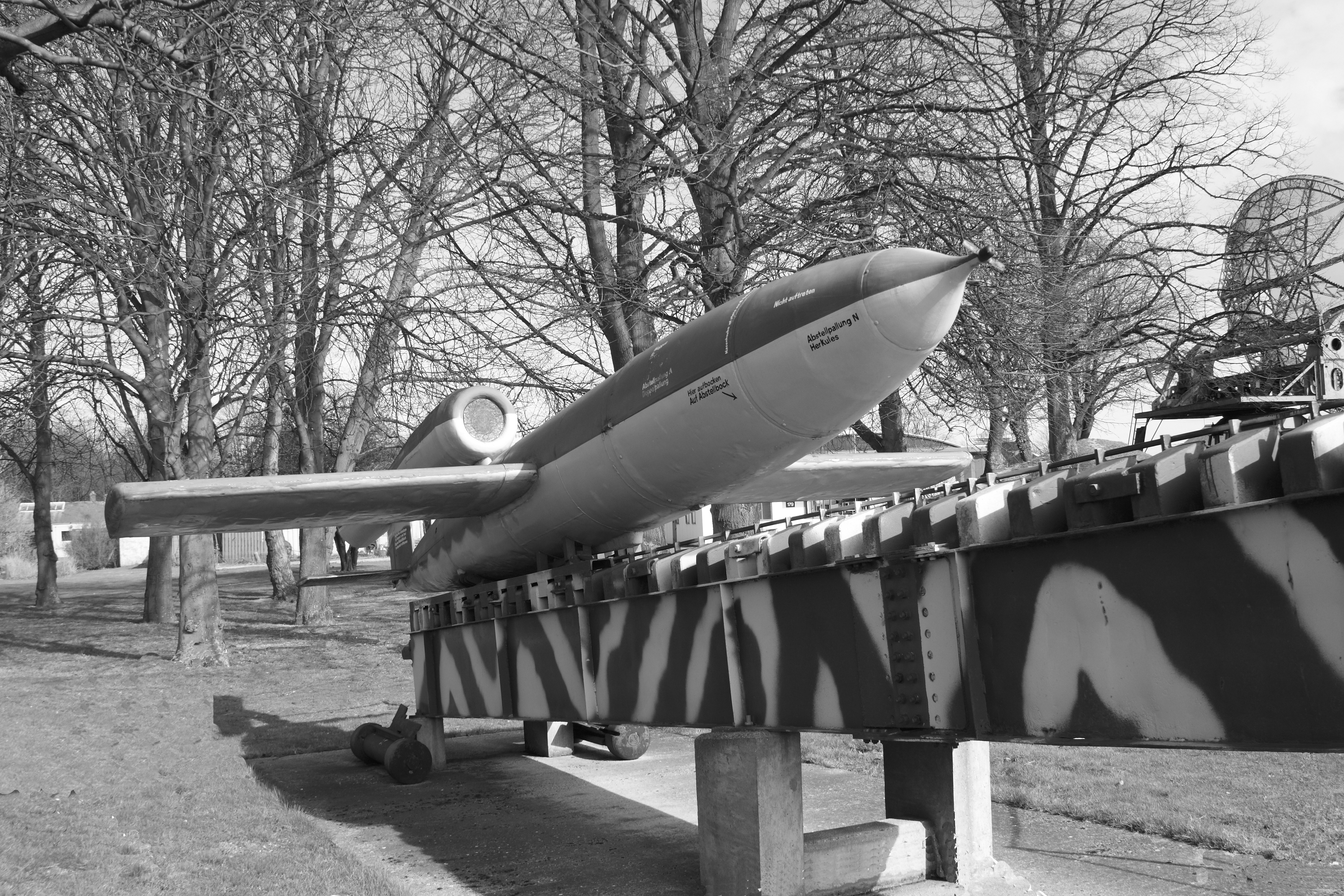
A superb example of the Doodlebug on its launch pad at Duxford.
By my compass it seemed to be aiming at my house in Wales!
The engine would always be started first using a compressed air line while the craft was stationary on the ramp. The low static thrust of the jet engine and very high stall speed of the small wings meant that the craft could not take off under its own power in a practically short distance, and thus required a catapult launch or an air launch from a modified bomber aircraft. Takeoff speed was commonly attained by launching from a ground ramp, using a chemical or steam catapult which accelerated the V-1 to 200 mph. A bit like the principle of steam catapults used on aircraft carriers.
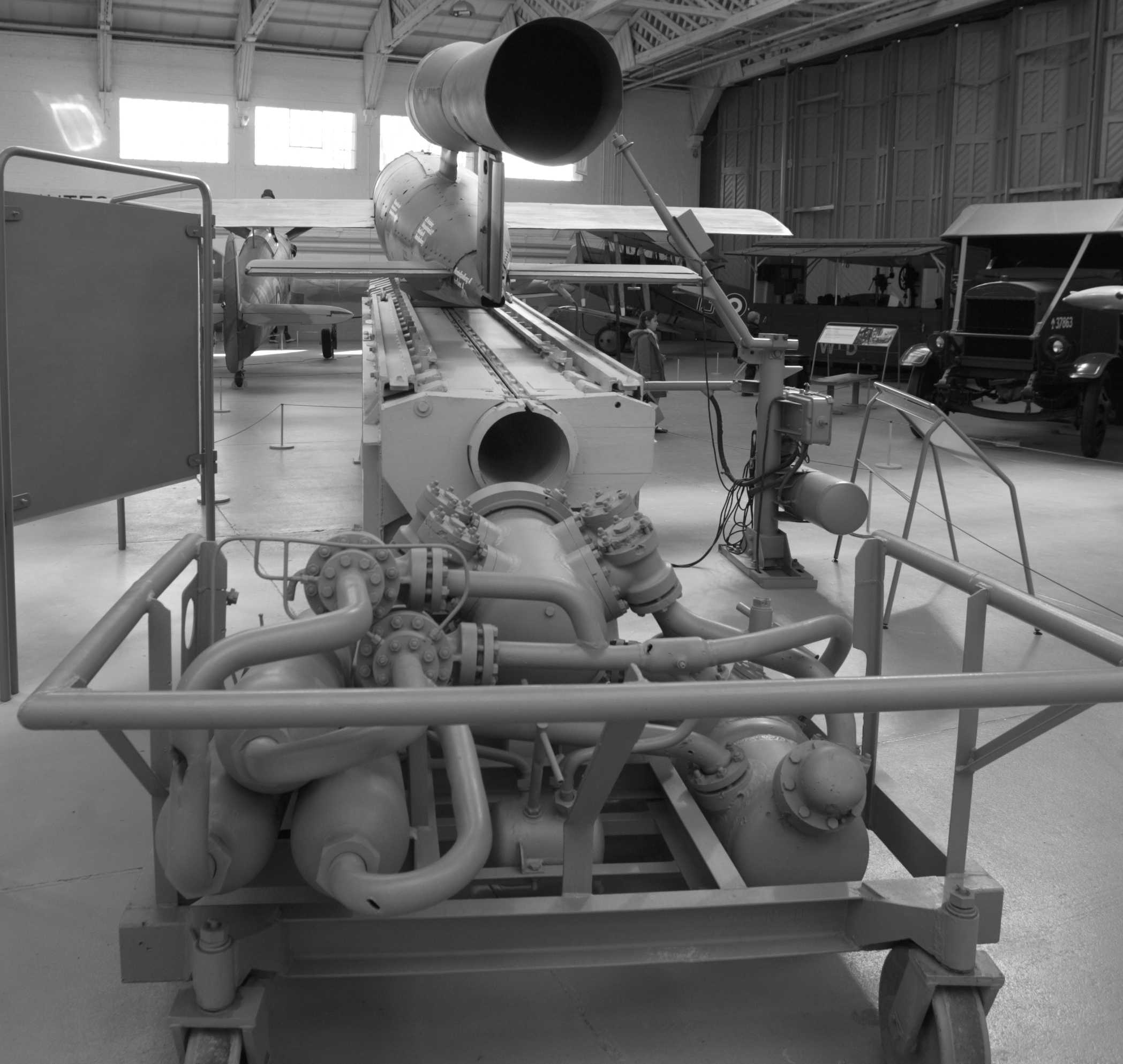
A V1 with Air Compressor ready for attaching to launch platform
This meant that the ramp used a special piston that was inserted in the central pipe that ran along the length of the ramp. The vertical blade in the piston ensured a smooth movement along the launch rail and the V1 became airborne with the piston dropping to the ground for possible reuse.

One of the steam driven pistons that launched the V1
The V-1 guidance system used a simple autopilot to regulate height and speed. This used a weighted pendulum system providing fore-and-aft attitude measurement to control pitch damped by a gyrocompass, which it also stabilized. The gyrocompass was set by swinging in a hangar before launch and controlled pitch and roll. The gyroscope stayed trued up by possibly sensing the magnetic field of the earth, and from the fore and aft pendulum. This meant that rudder control was enough without a separate banking mechanism. A countdown timer driven by a small propeller on the nose determined when target range had been reached. Before launching the counter was set to a value that would reach zero upon arrival at the target in the prevailing wind conditions. As the missile flew, the airflow turned the propeller and every 30 rotations of the propeller counted down one number on the counter. This counter triggered the arming of the warhead after about 38 miles. At the point when the counter reached zero the missile made two detonating bolts were fired. Two spoilers on the elevator were released, this caused the missile to have its forward flight “spoiled” and a stall in the air began. At the same time the linkage between the elevator and servo was jammed and a device cut off the control hoses to the rudder servo, setting the rudder in neutral. These actions led the V-1 into a steep dive. However the dive caused the fuel flow to cease, which stopped the engine. The sudden silence after the buzzing alerted listeners that the V-1 would impact soon. German scientists fixed the fuel shutoff and by the time the last V-1 fell, the majority had impacted under full power. With the counter determining how far the missile would fly, it was only necessary to launch the V-1 with the ramp in the rough direction and the autopilot controlled the rest.

Nose cone showing small propeller to measure target range
The first test flight of the V-1 was in late 1941 or early 1942 at Peenmunde. British Intelligence was aware of the existence of the device but details were sketchy. At that time only solid fuel rockets were considered to be in existence and the idea of a rocket that could fly over a 100 miles was dismissed. By the time it was realised it was not solid fuel that was in use the British had very good knowledge of what was going on. The British fed false information about the effect of V1 impacts to confuse the German intelligence service. On 13th June 1944 a week after D day the first V-1 struck London next to the railway bridge on Grove Road, Mile End which now carries a commemorative plaque. Eight civilians were killed in the blast.
A V1 takes off in a cloud of steam and smoke
Operation Crossbow was the codename of the British Defence.
Firstly a massive redeployment of anti-aircraft guns took place in several stage.;
Following on from D-day by Mid-June 1944 from sites on the North Downs across to the south coast of England, followed by a line to close off the Thames Estuary to attacks from the east. In September 1944, guns were place all along on the coast of East Anglia. In December 1944 there was a further line of guns along the East coast covering Lincolnshire to Yorkshire. The reason for this series of changes was that as the allies overran the various V1 launch sites the Germans began to concentrate their efforts other parts of the counties they held and this meant that the rockets came in from elsewhere.
Anti-aircraft crews near London thought that they were achieving considerable success on the night of the first sustained bombardment. They assumed that the targets they had shot at had been hit as their engines cut out and then the target fell to earth to burst into flames. They did not realise this was the V1 rocket doing what its makes had intended. Imagine their surprise when it was explained that these were not bombers and that they had not been bringing them down with gunfire. Experience showed that they were very hard to hit because they moved very fast making the task of following the target with a gun very hard and flew between 2,000 and 3,000 feet just above the effective range of light anti-aircraft guns and just below the starting range of the heavier guns.
Balloon Command was ordered to deploy large numbers of squadrons to the coast in an effort to fly balloons above the operating height of the rockets and cause them to come down. Some 2,000 barrage balloons deployed, in the hope that V-1s would be destroyed when they struck the balloons' tethering cables and deploy the double parachute links or the link with a bomb attached. It was claimed that the leading edges of the V-1's wings were fitted with cable cutters; I have never seen an example of these but can see that the leading edge of the wings was clearly thicker and therefore might have been able to break a cable. The wings of the V1 were quite stubby and much shorter than an aircraft. Balloons were claimed to have brought down around 300 V1 rockets. The wings of the V1 had hidden beneath the soft wing surface a series of balloon cable cutters made of a hardened steel edge. This illustration is one by Göran Jansson 2007 at www.zenza.se/vw for credit and link to more info on V1's
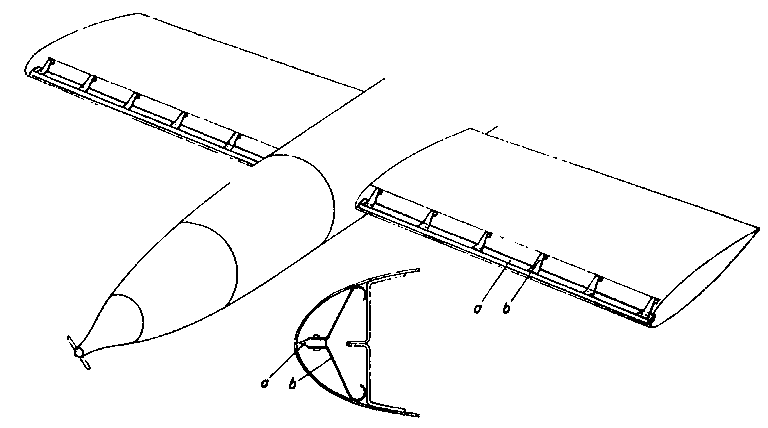
The cross section of the wing shows the cutter marked as "a", hidden underneath the wing surface. It is not known how effective they were but it is known that balloon cables did bring the "Divers" down as per the picture below.
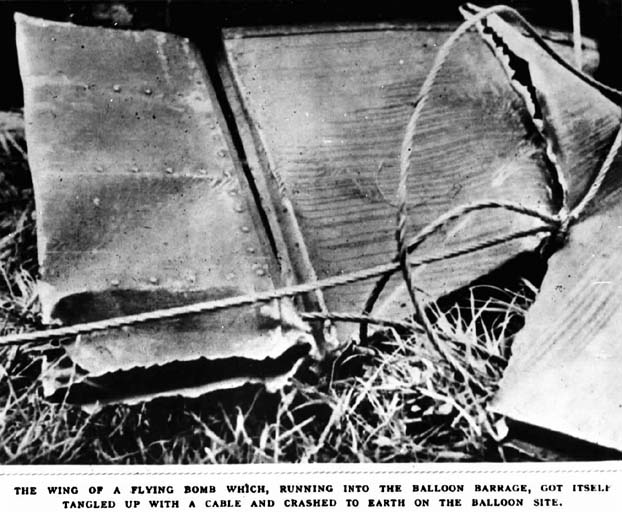
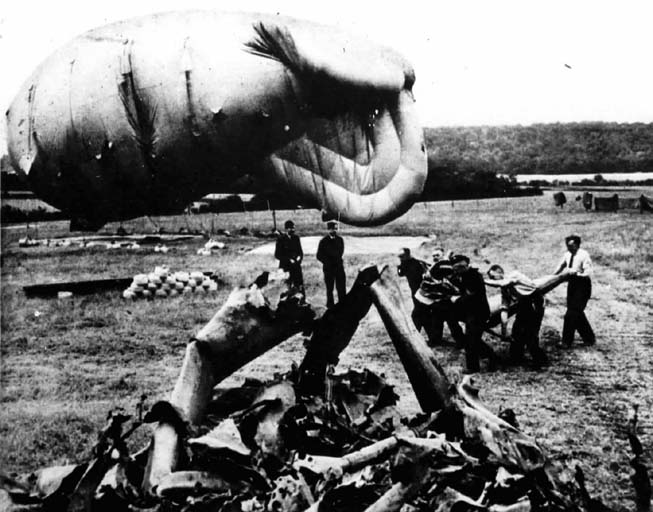
Balloon cables brought this "Diver" down in Kent and the Barrage Balloon crew are
clearing up the pieces.
Fighters were mobilized to intercept the V-1, but most fighter aircraft were too slow to catch a V-1. To give extra speed they would climb to a great height and then dive down to get maximum speed and attempt to attack the V1. It was hard to destroy. The best hope was a hit on the two bomb detonators and the line from the fuel tank, three very small targets buried inside the fuselage. A direct hit on the warhead by an explosive shell from a fighter's cannon, or a very close anti-aircraft shell explosion, were the most effective forms of gunfire, but not without risks to the pilot.

This shows a Spitfire attempting to “topple” a V1
Fighter aircraft tried to bring down the V1 by using a technique that required coolness and bravery. By sliding the wingtip to within six inches (15 cm) of the lower surface of the V-1's wing would cause disruption of the airflow and could cause one wing of the Doodlebug to rise. What was found was that if the V1 wing tip was made to raise this would cause the gyros to be overridden in theory and practice would cause a dive to the ground with no recovery. At least three V-1s were destroyed this way.
The V-1 launch sites could launch about 15 bombs per day, although this was never consistently achieved; the record was 18 in one day. Only a quarter hit their targets due to a combination of defensive measures mechanical unreliability and guidance errors.
Two electronic aids arrived to in mid-1944 to help AA Command, both developed in the USA, by using a British invention known as the cavity magnetron (Today this is what makes your microwave work!!). Centimetric gun-laying radars were excellent and along with the newly developed proximity fuse made anti-aircraft guns much more dangerous to attacking aircraft and V1’s.
17% of all flying bombs entering the coastal 'gun belt' were destroyed by guns in their first week on the coast. This rose to 60% by 23 August and 74% in the last week of the month, when on one day 82% were shot down. The rate improved from one V-1 destroyed for every 2,500 shells fired initially, to one for every 100. This still did not stem the problem, however, and the threat was not properly contained until the launch sites could be captured by infantry.
Almost 30,000 V-1s were made. Approximately 10,000 were fired at England; 2,419 reached London, killing about 6,184 people and injuring 17,981. 4,261 V-1s had been destroyed by fighters, anti-aircraft fire and barrage balloons. We were lucky that D-day took place when it did. If it had happened much later it is frightening to think of the damage the V1 would have caused as it was not until the allies had overrun every launch that the attacks were prevented.
The Royal Observation Corps were briefed to look out for them at the start of the V1 attacks and they were given the codename “Diver”. The RAF were able to issue a silhouette of its shape and size. On June 13th 1944, Colonel Wachtel's 'AA Regiment 155 (W)' launched its first salvo at London. The Royal Observer Corps Posts between Dover and Beachy Head were to have a frightening time observing and reporting this new threat, with the inevitable risk of injury from flying bombs that dived down early due to technical faults. There was a famous ‘ITMA’ phrase "Don't forget the Diver, - I'm going down now!" Which may have referred to the sudden dive of the V1 flying bomb? When the controls dropped the nose of the V1 for the dive, the petrol-feed to the pulse-jet engine cut out. This unintentional warning gave seconds for those in the target area to take cover, reducing the casualty list. For a superb in depth and detailed review of the V1 go the paper by Göran Jansson 2007 at www.zenza.se/vw for credit and link to more info on V1's
The W.O.T.1. Barrage Balloon Winch Vehicle on Display at Duxford
I was a little disappointed at the way the vehicle was displayed but Duxford is always short of room and I was really only able to photograph 3 sides of the winch. However it does look in good condition. The gas trailer was not well displayed and was separate from the winch vehicle. The gas trailer certainly is not in the best of condition and presumably is due to be given a overhaul for preservation soon.
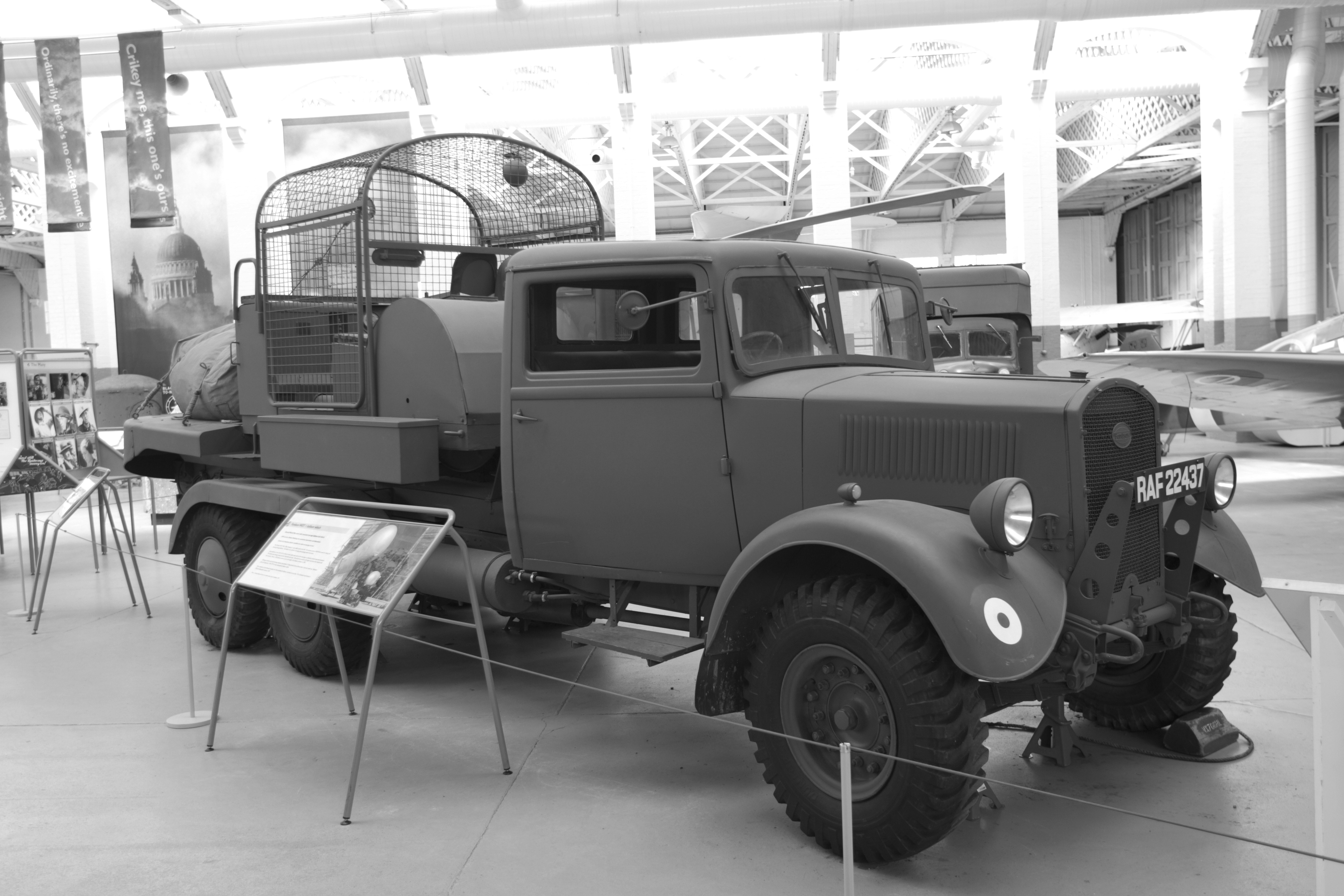
The WAr Office Type (W.O.T.) Type 1 Winch Lorry - Ken Kelly will love seeing this again!

The brief history of this vehicle is that it was owned by the Imperial War Museum and when they first had it it was mounted on a chassis that was
much longer than the usual chassis used in wartime. To restore the authentic look the winch was removed and taken away by Eddie Smith and Ken Kelly
and the chassis cut down and rebuilt to look exactly as it would have done in WWII. It was then sprayed in wartime camouflage and returned to be put on show.
The attention to detail is quite incredible and the many man-hours spent achieving this was incredible.
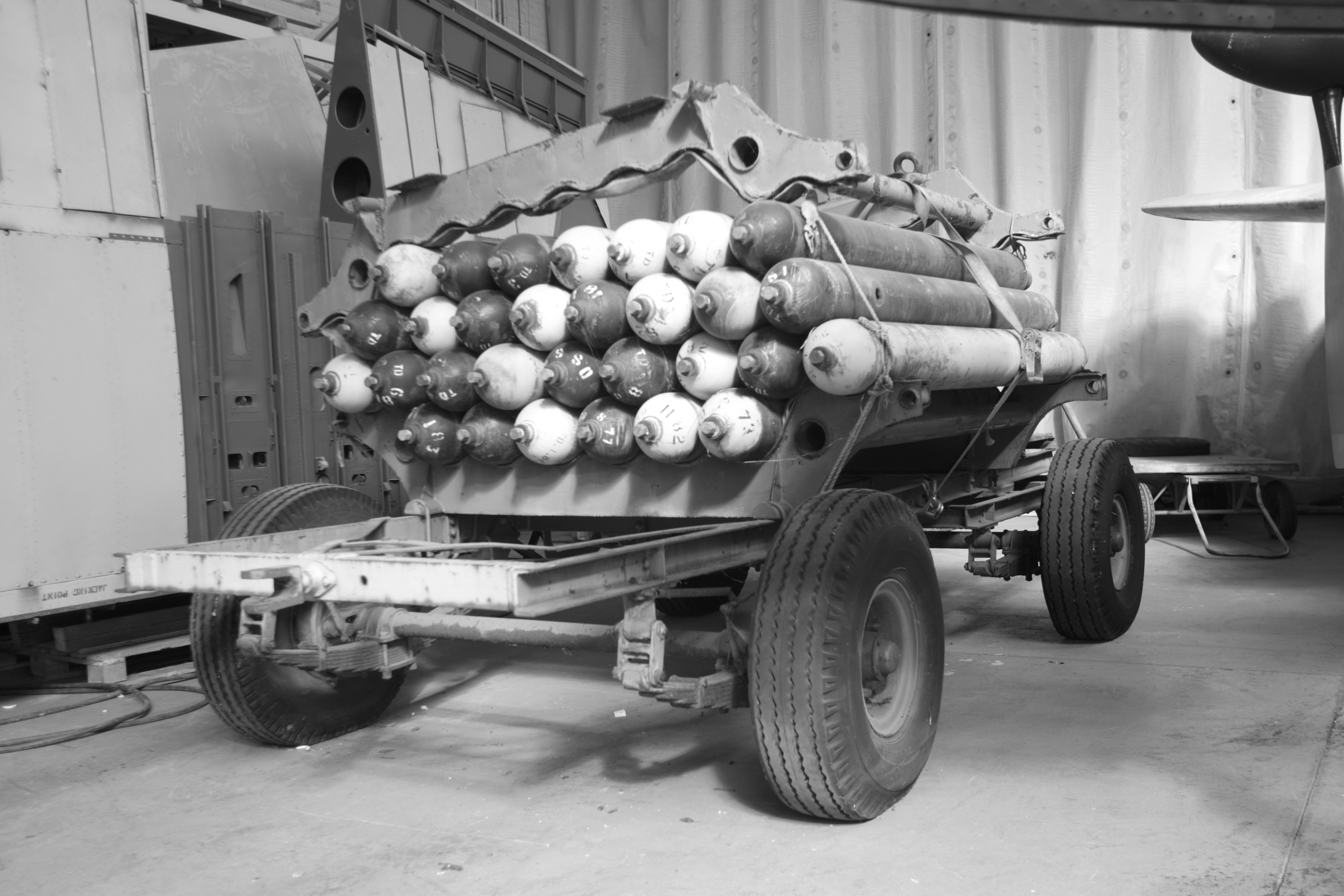
The Gas Trailer on display with a spare cradle.
This cradle is clearly in need of further preservation but is an excellent example of the type of gas trailer used in WWII.
During our day there I had hoped to see and photograph a aircraft wing with a balloon cutter cable device, I was amazed when I failed to find any on display!
One of the staff was intrigued by my request and confirmed that of all the exhibits of aircraft on display not one has got a cable cutting device! It was suggested
that as the war went on many of the devices were removed with time as they were not needed and they made the aircraft simpler and lighter in use.
They did agree to check their exhibit list and if they have any they will be the basis of a future article.
Duxford is a great day out is not too far from Cambridge and London and has a large number of hangars where aviation exhibits are on display from all eras of aviation. It is pleasing to see the role of Balloon Command represented there.
There is a charge to enter Duxford (Concessions apply) but they have a wonderful picnic site outside as well as indoor restaurants. There is a considerable distance to walk around the site but they do have shuttle bus to take you from one hangar to another. We had a great day out. Overall it is well laid out and has plenty of facilities such as resting places, toilets and staff to assist. I can thoroughly recommend a day out at “Doodling” at Duxford.